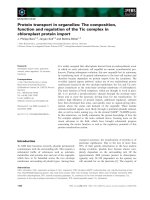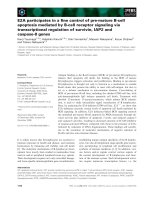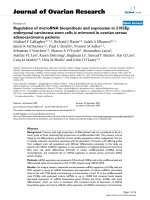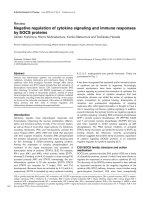Regulation of Fluid Volume and Composition
Bạn đang xem bản rút gọn của tài liệu. Xem và tải ngay bản đầy đủ của tài liệu tại đây (478.98 KB, 7 trang )
Regulation of Fluid Volume and Composition
Regulation of Fluid Volume
and Composition
Bởi:
OpenStaxCollege
The major hormones influencing total body water are ADH, aldosterone, and ANH.
Circumstances that lead to fluid depletion in the body include blood loss and
dehydration. Homeostasis requires that volume and osmolarity be preserved. Blood
volume is important in maintaining sufficient blood pressure, and there are nonrenal
mechanisms involved in its preservation, including vasoconstriction, which can act
within seconds of a drop in pressure. Thirst mechanisms are also activated to promote
the consumption of water lost through respiration, evaporation, or urination. Hormonal
mechanisms are activated to recover volume while maintaining a normal osmotic
environment. These mechanisms act principally on the kidney.
Volume-sensing Mechanisms
The body cannot directly measure blood volume, but blood pressure can be measured.
Blood pressure often reflects blood volume and is measured by baroreceptors in the
aorta and carotid sinuses. When blood pressure increases, baroreceptors send more
frequent action potentials to the central nervous system, leading to widespread
vasodilation. Included in this vasodilation are the afferent arterioles supplying the
glomerulus, resulting in increased GFR, and water loss by the kidneys. If pressure
decreases, fewer action potentials travel to the central nervous system, resulting in more
sympathetic stimulation-producing vasoconstriction, which will result in decreased
filtration and GFR, and water loss.
Decreased blood pressure is also sensed by the granular cells in the afferent arteriole
of the JGA. In response, the enzyme renin is released. You saw earlier in the chapter
that renin activity leads to an almost immediate rise in blood pressure as activated
angiotensin II produces vasoconstriction. The rise in pressure is sustained by the
aldosterone effects initiated by angiotensin II; this includes an increase in Na+ retention
and water volume. As an aside, late in the menstrual cycle, progesterone has a modest
influence on water retention. Due to its structural similarity to aldosterone, progesterone
1/7
Regulation of Fluid Volume and Composition
binds to the aldosterone receptor in the collecting duct of the kidney, causing the same,
albeit weaker, effect on Na+ and water retention.
Cardiomyocytes of the atria also respond to greater stretch (as blood pressure rises) by
secreting ANH. ANH opposes the action of aldosterone by inhibiting the recovery of
Na+ by the DCT and collecting ducts. More Na+ is lost, and as water follows, total blood
volume and pressure decline. In low-pressure states, ANH does not seem to have much
effect.
ADH is also called vasopressin. Early researchers found that in cases of unusually high
secretion of ADH, the hormone caused vasoconstriction (vasopressor activity, hence the
name). Only later were its antidiuretic properties identified. Synthetic ADH is still used
occasionally to stem life-threatening esophagus bleeding in alcoholics.
When blood volume drops 5–10 percent, causing a decrease in blood pressure, there is
a rapid and significant increase in ADH release from the posterior pituitary. Immediate
vasoconstriction to increase blood pressure is the result. ADH also causes activation of
aquaporin channels in the collecting ducts to affect the recovery of water to help restore
vascular volume.
Diuretics and Fluid Volume
A diuretic is a compound that increases urine volume. Three familiar drinks contain
diuretic compounds: coffee, tea, and alcohol. The caffeine in coffee and tea works by
promoting vasodilation in the nephron, which increases GFR. Alcohol increases GFR
by inhibiting ADH release from the posterior pituitary, resulting in less water recovery
by the collecting duct. In cases of high blood pressure, diuretics may be prescribed
to reduce blood volume and, thereby, reduce blood pressure. The most frequently
prescribed anti-hypertensive diuretic is hydrochlorothiazide. It inhibits the Na+/ Cl–
symporter in the DCT and collecting duct. The result is a loss of Na+ with water
following passively by osmosis.
Osmotic diuretics promote water loss by osmosis. An example is the indigestible sugar
mannitol, which is most often administered to reduce brain swelling after head injury.
However, it is not the only sugar that can produce a diuretic effect. In cases of poorly
controlled diabetes mellitus, glucose levels exceed the capacity of the tubular glucose
symporters, resulting in glucose in the urine. The unrecovered glucose becomes a
powerful osmotic diuretic. Classically, in the days before glucose could be detected
in the blood and urine, clinicians identified diabetes mellitus by the three Ps: polyuria
(diuresis), polydipsia (increased thirst), and polyphagia (increased hunger).
2/7
Regulation of Fluid Volume and Composition
Regulation of Extracellular Na+
Sodium has a very strong osmotic effect and attracts water. It plays a larger role in the
osmolarity of the plasma than any other circulating component of the blood. If there
is too much Na+ present, either due to poor control or excess dietary consumption,
a series of metabolic problems ensue. There is an increase in total volume of water,
which leads to hypertension (high blood pressure). Over a long period, this increases the
risk of serious complications such as heart attacks, strokes, and aneurysms. It can also
contribute to system-wide edema (swelling).
Mechanisms
for
regulating
Na+
concentration
include
the
renin–angiotensin–aldosterone system and ADH (see [link]). Aldosterone stimulates
the uptake of Na+ on the apical cell membrane of cells in the DCT and collecting
ducts, whereas ADH helps to regulate Na+ concentration indirectly by regulating the
reabsorption of water.
Regulation of Extracellular K+
Potassium is present in a 30-fold greater concentration inside the cell than outside
the cell. A generalization can be made that K+ and Na+ concentrations will move in
opposite directions. When more Na+ is reabsorbed, more K+ is secreted; when less
Na+ is reabsorbed (leading to excretion by the kidney), more K+ is retained. When
aldosterone causes a recovery of Na+ in the nephron, a negative electrical gradient is
created that promotes the secretion of K+ and Cl– into the lumen.
Regulation of Cl–
Chloride is important in acid–base balance in the extracellular space and has other
functions, such as in the stomach, where it combines with hydrogen ions in the stomach
lumen to form hydrochloric acid, aiding digestion. Its close association with Na+ in
the extracellular environment makes it the dominant anion of this compartment, and its
regulation closely mirrors that of Na+.
Regulation of Ca++ and Phosphate
The parathyroid glands monitor and respond to circulating levels of Ca++ in the blood.
When levels drop too low, PTH is released to stimulate the DCT to reabsorb Ca++ from
the forming urine. When levels are adequate or high, less PTH is released and more
3/7
Regulation of Fluid Volume and Composition
Ca++ remains in the forming urine to be lost. Phosphate levels move in the opposite
direction. When Ca++ levels are low, PTH inhibits reabsorption of HPO24 − so that its
blood level drops, allowing Ca++ levels to rise. PTH also stimulates the renal conversion
of calcidiol into calcitriol, the active form of vitamin D. Calcitriol then stimulates the
intestines to absorb more Ca++ from the diet.
Regulation of H+, Bicarbonate, and pH
The acid–base homeostasis of the body is a function of chemical buffers and physiologic
buffering provided by the lungs and kidneys. Buffers, especially proteins, HCO23 − , and
ammonia have a very large capacity to absorb or release H+ as needed to resist a change
in pH. They can act within fractions of a second. The lungs can rid the body of excess
acid very rapidly (seconds to minutes) through the conversion of HCO3– into CO2,
which is then exhaled. It is rapid but has limited capacity in the face of a significant
acid challenge. The kidneys can rid the body of both acid and base. The renal capacity
is large but slow (minutes to hours). The cells of the PCT actively secrete H+ into the
forming urine as Na+ is reabsorbed. The body rids itself of excess H+ and raises blood
pH. In the collecting ducts, the apical surfaces of intercalated cells have proton pumps
that actively secrete H+ into the luminal, forming urine to remove it from the body.
As hydrogen ions are pumped into the forming urine, it is buffered by bicarbonate
(HCO3–), H2PO4– (dihydrogen phosphate ion), or ammonia (forming NH4+, ammonium
ion). Urine pH typically varies in a normal range from 4.5 to 8.0.
Regulation of Nitrogen Wastes
Nitrogen wastes are produced by the breakdown of proteins during normal metabolism.
Proteins are broken down into amino acids, which in turn are deaminated by having their
nitrogen groups removed. Deamination converts the amino (NH2) groups into ammonia
(NH3), ammonium ion (NH4+), urea, or uric acid ([link]). Ammonia is extremely toxic,
so most of it is very rapidly converted into urea in the liver. Human urinary wastes
typically contain primarily urea with small amounts of ammonium and very little uric
acid.
4/7
Regulation of Fluid Volume and Composition
Nitrogen Wastes
Elimination of Drugs and Hormones
Water-soluble drugs may be excreted in the urine and are influenced by one or all of
the following processes: glomerular filtration, tubular secretion, or tubular reabsorption.
Drugs that are structurally small can be filtered by the glomerulus with the filtrate. Large
drug molecules such as heparin or those that are bound to plasma proteins cannot be
filtered and are not readily eliminated. Some drugs can be eliminated by carrier proteins
that enable secretion of the drug into the tubule lumen. There are specific carriers that
eliminate basic (such as dopamine or histamine) or acidic drugs (such as penicillin or
indomethacin). As is the case with other substances, drugs may be both filtered and
reabsorbed passively along a concentration gradient.
Chapter Review
The major hormones regulating body fluids are ADH, aldosterone and ANH.
Progesterone is similar in structure to aldosterone and can bind to and weakly stimulate
aldosterone receptors, providing a similar but diminished response. Blood pressure is
a reflection of blood volume and is monitored by baroreceptors in the aortic arch
and carotid sinuses. When blood pressure increases, more action potentials are sent to
the central nervous system, resulting in greater vasodilation, greater GFR, and more
water lost in the urine. ANH is released by the cardiomyocytes when blood pressure
increases, causing Na+ and water loss. ADH at high levels causes vasoconstriction in
addition to its action on the collecting ducts to recover more water. Diuretics increase
urine volume. Mechanisms for controlling Na+ concentration in the blood include the
renin–angiotensin–aldosterone system and ADH. When Na+ is retained, K+ is excreted;
when Na+ is lost, K+ is retained. When circulating Ca++ decreases, PTH stimulates
the reabsorption of Ca++ and inhibits reabsorption of HPO24 − . pH is regulated through
buffers, expiration of CO2, and excretion of acid or base by the kidneys. The breakdown
of amino acids produces ammonia. Most ammonia is converted into less-toxic urea
5/7
Regulation of Fluid Volume and Composition
in the liver and excreted in the urine. Regulation of drugs is by glomerular filtration,
tubular secretion, and tubular reabsorption.
Review Questions
Which of these beverages does not have a diuretic effect?
1.
2.
3.
4.
tea
coffee
alcohol
milk
D
Progesterone can bind to receptors for which hormone that, when released, activates
water retention?
1.
2.
3.
4.
aldosterone
ADH
PTH
ANH
A
Renin is released in response to ________.
1.
2.
3.
4.
increased blood pressure
decreased blood pressure
ACE
diuretics
B
Critical Thinking Questions
Why is ADH also called vasopressin?
When first discovered, it was named for its known activity—vasoconstriction.
How can glucose be a diuretic?
6/7
Regulation of Fluid Volume and Composition
In cases of diabetes mellitus, there is more glucose present than the kidney can recover
and the excess glucose is lost in the urine. It possesses osmotic character so that it
attracts water to the forming urine.
7/7









